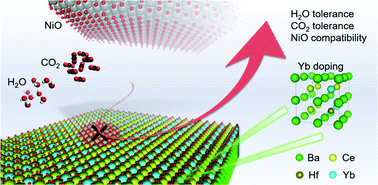Critical role of acceptor dopants in designing highly stable and compatible proton-conducting electrolytes for reversible solid oxide cells†
Abstract
Proton-conducting electrolytes are receiving increasing attention due to their high ionic conductivity at intermediate temperatures, enabling the operation of solid oxide cells with high energy efficiency at low cost. However, the effect of B-site dopants on the properties of doped barium hafnate-cerate electrolyte materials, especially in single cells under operating conditions, has not been systematically studied. Here we report our findings in the development of a series of proton-conducting electrolytes with a general formula of BaHf0.1Ce0.7R0.2O3−δ (BHCR172, R = Yb, Er, Y, Gd, Sm). The results reveal that electrical conductivity, ionic transference number, chemical stability against steam and CO2, and compatibility with NiO during sintering are all closely correlated with the dopant size. In particular, the reaction with NiO is found to strongly affect the properties of the electrolytes and hence cell performance. Among all tested compositions, BaHf0.1Ce0.7Yb0.2O3−δ (BHCYb172) shows excellent chemical stability and minimal reactivity towards NiO, as predicted from density functional theory (DFT)-based calculations and confirmed by experimental results. In addition, proton-conducting reversible solid oxide cells (P-ReSOCs) based on the optimized electrolyte composition, BHCYb172, demonstrate exceptional performance and stability, achieving a remarkable peak power density of 1.74 W cm−2 (O2 as the oxidant) at 600 °C in the fuel cell mode and a high current density of 2.0 A cm−2 at 1.3 V and 600 °C in the steam electrolysis mode while maintaining excellent durability for over 1000 h.

- This article is part of the themed collection: Energy & Environmental Science Recent HOT Articles


 Please wait while we load your content...
Please wait while we load your content...
